The Chelsea Flower Show in London represents the pinnacle of garden design. It is, without question, an annual opportunity to check in with many of industry’s leaders to see what they are thinking about and how they choose to represent the artistry and influence in the world. This year, I’ve combined my thoughts and takeaways with Gillian Carson’s (of My Tiny Plot) first hand experiences. She took in Chelsea’s 2015 flower show as a spectator on press day as well as on public days. I took it all in front my desk chair in Boston. Her perspective comes as a British garden writer and blogger as well gardener (in the USA) who has made many Chelsea trips in the past and has seen many styles and trends come and go.
If you’d like to see the Chelsea Flower Show 2015 from the other outside – during buildup, this year we also have coverage from Carrie Preston (of Studio Toop).
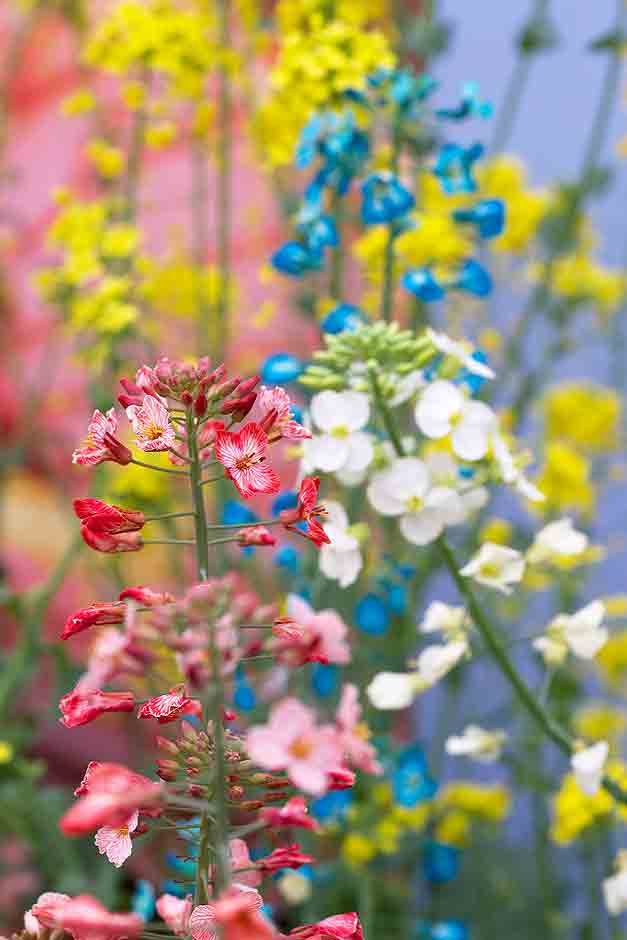
Chelsea Sets the Tone for the Gardening World
My personal experience of Chelsea was life changing. It is the reason I am in this industry at all. Taking time out annually to studying every piece of it from every angle brings me not only personal joy and satisfaction, but it is also an opportunity to reconnect with myself and remember why I have chosen my career path.
The plants, the ideas, the personal stories, the triumphs and the failures fill hours of British television and countless pages of magazines and newspapers across the world. I’m interested in it all but to start, I like to focus on trends and ideas that I see emerging.
I’ve been pouring through the images of the gardens and exhibits (mostly on the RHS website) from my desk outside of Boston. I’m taking in the perspective that is to be had when you are looking through someone else’s lens. I’ve woven together Gillian Carson’s thoughts in here too.
Have you been following show coverage? What trends do you see? Feel free to leave comments!
Stumps and Dead Wood As Garden Features
It seems the concepts behind hugelkultur are continuing to permeate into our collective minds.
Stumps and sticks and what once would never be put on display as something beautiful are increasingly taking center stage.
A stumpery is similar to a rockery but made from parts of dead trees. Stumperys (Im not sure how to spell the plural!) were first imagined in Victorian times and are being revisited. The structural form of a stumpery is of an upturned tree. We’re also seeing this trend in unfinished and live wood edges in interior design. As always, what is trendy in interiors often trickles into trendy exteriors.
The trend has left me wondering if, at long last, garden fashion might be catching up with or *gasp* perhaps even taken a lead role in setting general lifestyle and fashion trends? Probably not.
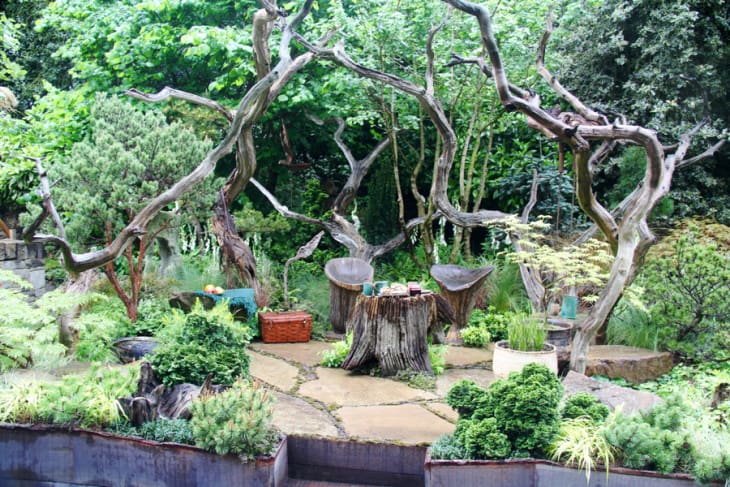
Gillian: Dead wood, stumps and stumperies are one of the big style trends at Chelsea this year. The Sculptor Picnic garden by Graham Bodle is mostly wood sculpture and took away a gold among Artisan gardens.

Natural Texture and Naturalistic Planting Emerges at Chelsea Flower Show 2015

There were, as always, gardens that had shiny sleek curves, imported stone terraces, and generally modern lines everywhere. But the places that seemed most of the moment, (and also took the big prizes for people’s choice and best in show) were gardens that eschewed all this for a more natural look.
These naturalistic gardens walked the line between the nostalgia gardens (that seek to recreate in great detail some long-lost time and place) and something more modern.
They (and specifically Dan Pearson’s Best in Show Garden above) didn’t shy away from combining manicured shrubbery and rock formations that would be extremely rare to find in untouched nature with planting that celebrates weeds, scrawny specimens and plants that are anything but the (often) over-amped hybrids that flood the market.
I personally find this line difficult to walk but something I admire tremendously.
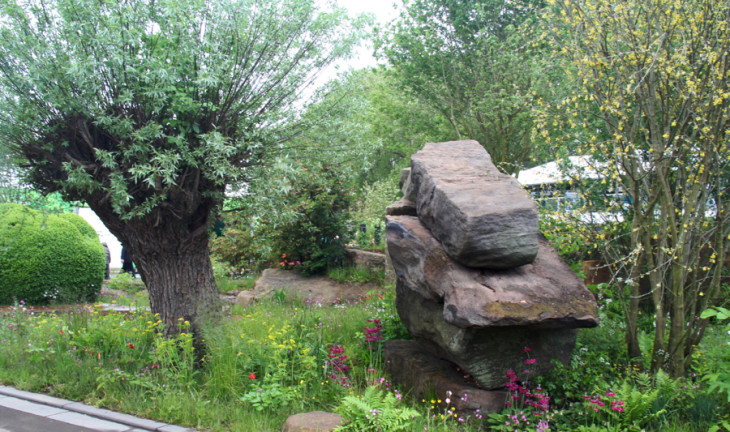
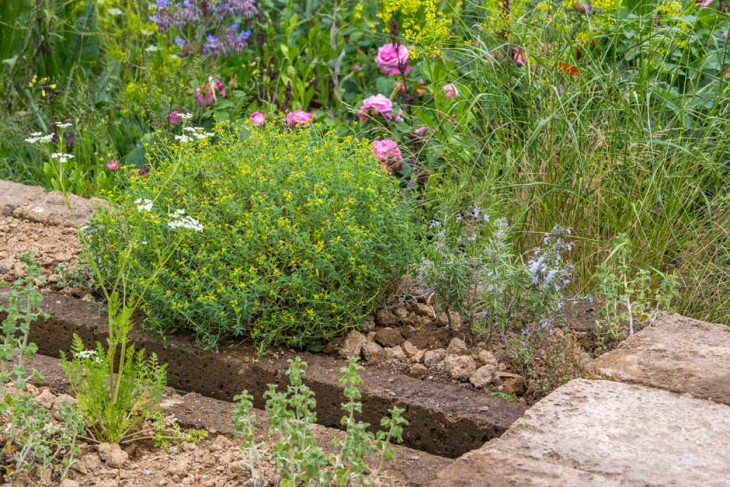
The Perfumers Garden is another example of natural texture. Rills made of hypertufa run through plants that were chosen for fragrance (again more wild and weedy than plump and voluptuous choice). The paths are hoggin and provide a semi-permeable surface that is low maintenance, inexpensive and ecologically preferable to many other types of paving.
Hoggin is a compactable groundcover that is composed of a mixture of clay, gravel, and sand or granite dust that produces a buff-coloured bound surface. I’m stumped to think if we have an american-english version of this word? Crusher fines? Decomposed Granite?
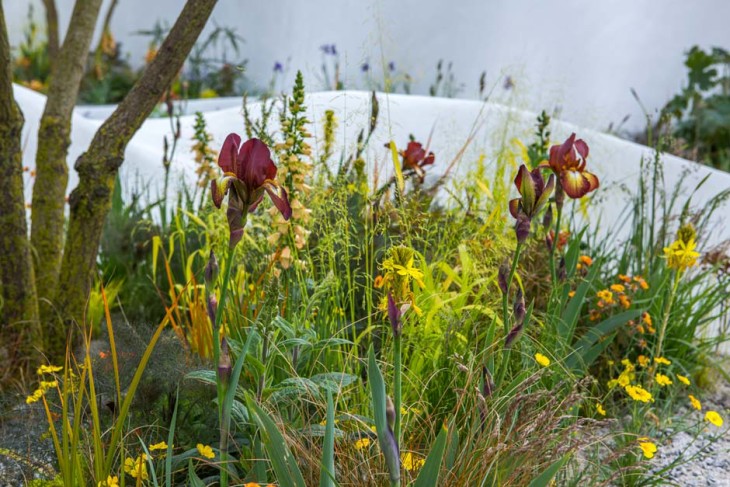
Even where a more modern and look was created, as in the Pure Land Foundation Garden, the shaped and texture remained natural with a stucco finish and smooth flowing lines.
The Old Forge garden by Jodie Fedora and Martin Anderson features an abandoned forge that is being taken over by native wildflowers and dandelions.
Color – Is Orange the new black at Chelsea Flower Show 2015?
I’m not sure I saw a single garden that relied on the pastel tones that seem so popular (like, yesterday). If flowers took a central role (note that in many gardens they did not – see texture) they tended to be in dynamic mixes of orange (tangerine colored Geum was everywhere) purple, and red.
There is a distinct vibrance with the planting and flowers that is notable across the entire show

Gillian says that on the ground, orange was a more obvious trend. She reports: “If you follow Chelsea trends then orange is definitely the new black. Burnt orange, maybe mustard or rust and in many cases connected to Irises especially at The Pure Land Foundation garden.” (A gold medal winner)
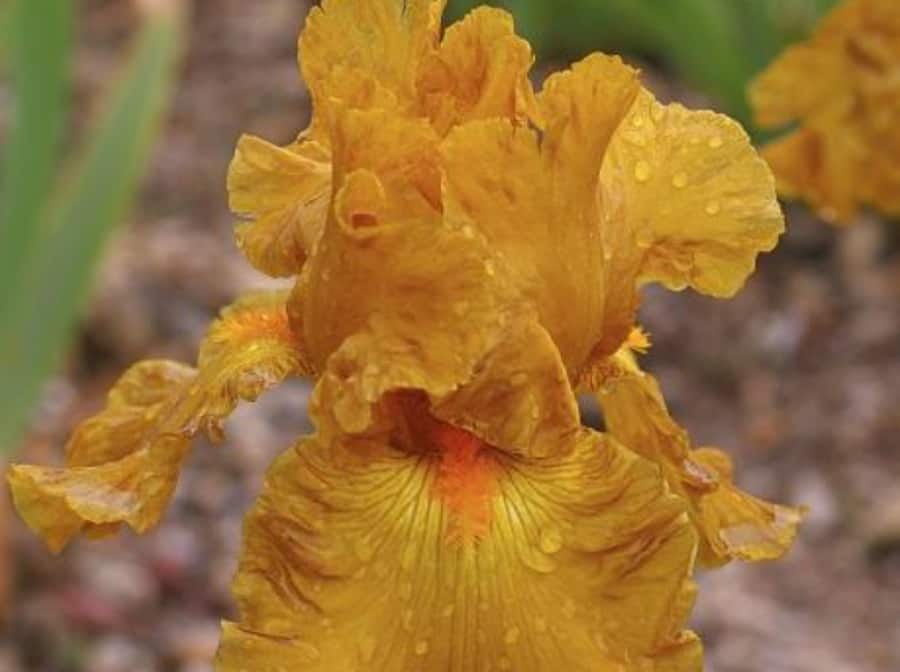
It is hard to take in every detail when you aren’t there to direct your own eye. The internet and TV coverage always leaves us at the mercy of the camera holder. We only see what they are looking at.
Gillian Noted a few more trends from her in-person visit here are her thoughts:
Statement Trees
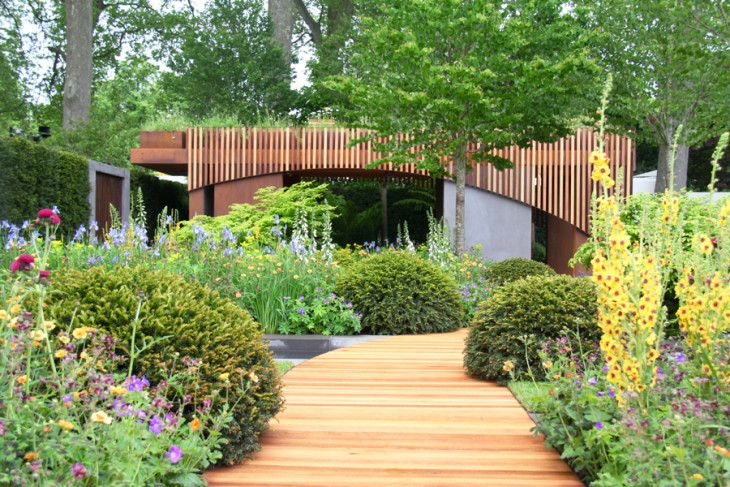
The Brewin Dolphin garden by Darren Hawkes features several large smaller-leaves Elm trees (Ulmus minor), while The Homebase garden by Adam Frost showed six imposing Katsura trees (Cercidiphyllum japonicum).
Metal Sculptures of People
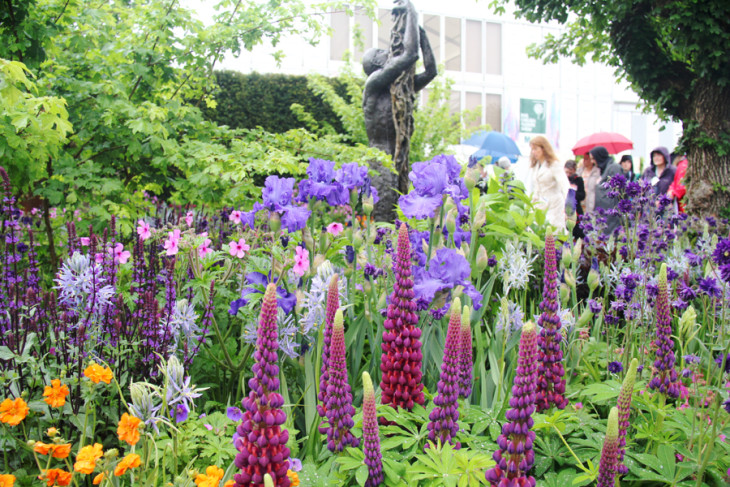
Almost every garden had a sculpture of some description and many of them chose metal people as the theme. The Breakthrough Breast Cancer garden by Ruth Willmott displayed a lovely torso of a woman in silver with holes punched through it.
The Evaders garden by John Everiss featured a crouching figure. It was partially hidden and constructed of see-through slatted metal. There were many more.
Lysimachia ‘Beaujolais’
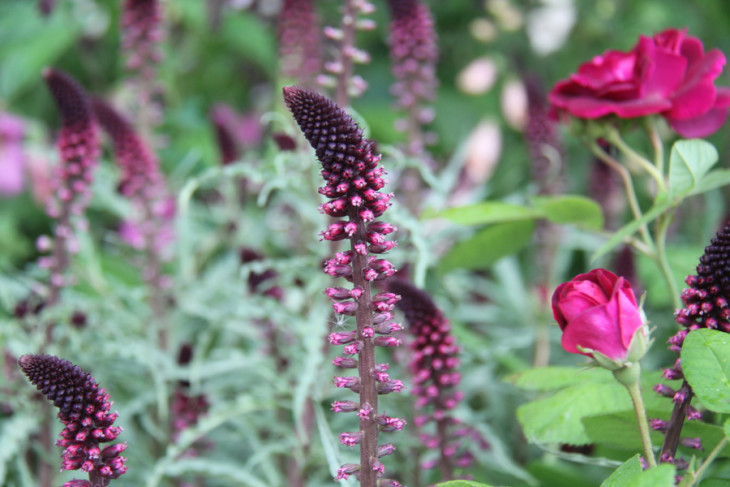
This one single plant figures in many of the show gardens this year. Its red wine color really pops out against lighter colors and its understated, glaucous leaves lend an elegance to any garden.
Verbascums, Foxgloves, Lupins
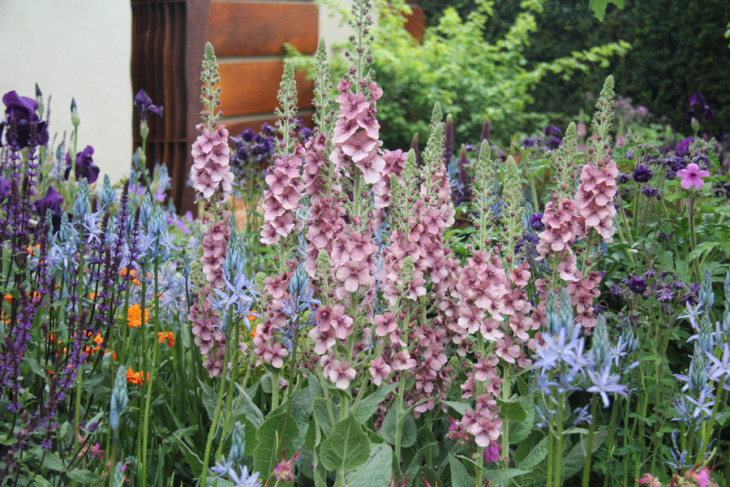
Verbascums are everywhere in the show gardens. Their colors are muted too. Think Edwardian ladies, dusky pinks, pale orange with just a peek of pink. This one is Verbascum ‘Clementine’ but Verbascum ‘Merlin’ is a pink variety that makes an appearance in Chris Beardshaw’s Healthy Cities Garden (gold medal winner).
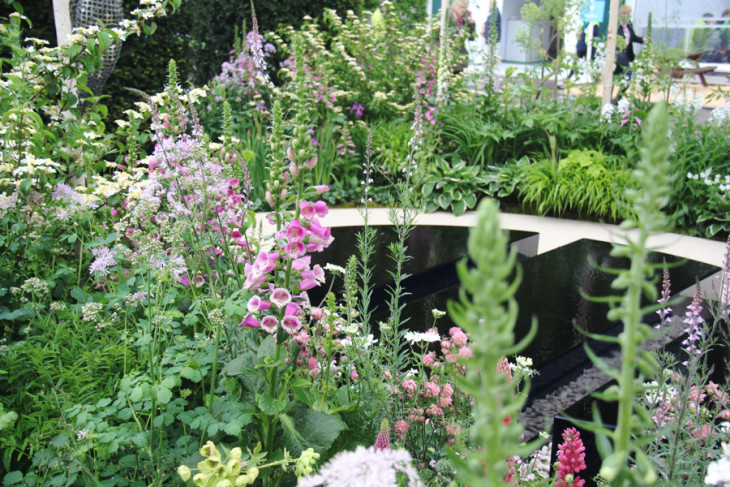
Foxgloves seem to be a given at Chelsea. Like Wimbledon and strawberries it simply isn’t Chelsea without them. Their colors are more muted this year though. Lot’s of pale yellows, and baby pinks.
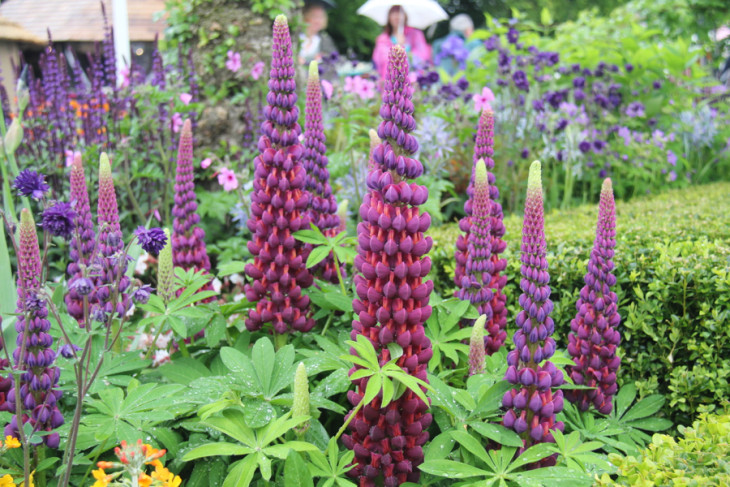
Again Lupins feature quite highly on every garden’s plant list. It hard to explain why. They are quite out of favor outside the confines of the show garden. But they keep coming back. Maybe it’s because they offer such a straight spire with a wide range of impactful, reliable colors. They really are a garden designer’s secret weapon.
Japanese Moss Balls
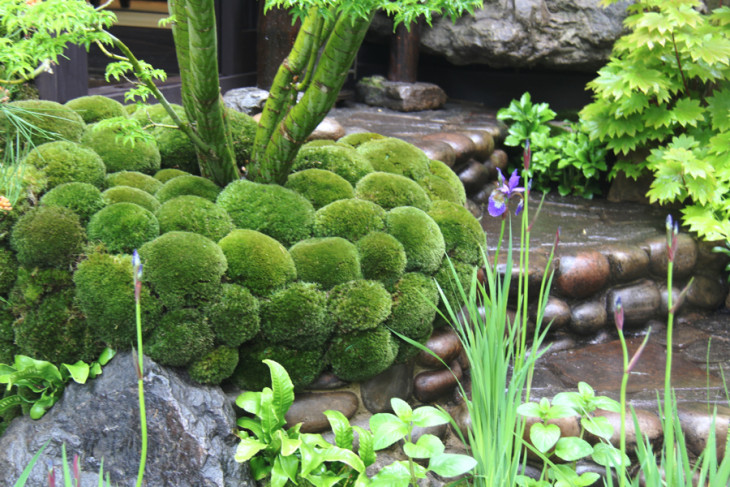
Moss balls are popping up everywhere but were especially prevalent here at The Edo no Niwa – Edo Garden by Ishihara Kazuyuki Design Laboratory (gold medal winner). I love the way that their rounded edges echo the pebble steps.
Our Overall take on the 2015 Chelsea Flower Show?
The show highlighted and tweaked versions of weedy and wild, with an ever increasing nod to methods and practices celebrated by permaculturists. Naturalism is a trend but we are hanign on to old fashioned and fairly unfashionable favorites. What is your take?
More coverage of The Chelsea Flower Show from over the years:
images top: Purple and orange and white combine in the Sentebale – Hope in Vulnerability garden designed by Matt Keightley and built by Rosebank. Poppies, Geum and thistle make for an airy mix of planting in the Trugmakers Garden designed by Serena Fremantl and Tina Vallis and built by Frogheath Landscapes Ltd. all other images from RHS, or Gillian Carson
+comments+